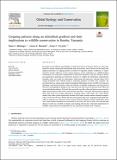| dc.description.abstract | Ecosystem and livelihood sustainability of small-scale farmers in Eastern Africa are often challenged by climate change and unsustainable land use practices. Little is known on the small-scale
temporal processes of cropping systems in relation to long-term climatic conditions. To understand the climatic influence on the cropping patterns, and its implications to wildlife/elephant
conservation, our study used a combination of time-series datasets on crop and climate as well as
geo-spatial layers spanning more than three decades. To validate the information analyzed from
secondary data, we carried out participatory observation and interviews, whereby about 5% of
village households were selected along an altitudinal gradient of Rombo area, Tanzania. We
generated land use change maps using Geographical Information System (ArcGIS 10.4) and used
Spearman’s correlation analysis to assess the influence of rainfall, temperature, and crop yield on
the observed longitudinal changes in the crop types and other land use patterns both within and
across altitudinal gradients. We found that perennial crops like coffee and banana concentrated in
upper agro-ecological zones, with a clear division line above 1230 masl while seasonal crops like
maize and beans were mostly cultivated in lowlands (below 1230 masl). The results further
showed that coffee yields significantly declined with higher average annual minimum temperatures over the last 16 years. Within the same time period, there was a disproportionate shift from
coffee to seasonal crop cultivation such as maize and beans. Elephant numbers declined by about
38%, while human settlement area increased by 28% over the last 30 years. We conclude that
changes in land use and shifts in climate and cropping patterns have important implications for
elephant conservation and sustainability of the ecosystem in Rombo area, Tanzania. | en_US |

